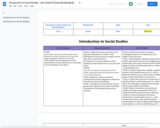
Explain how the physical and human characteristics of early civilizations are connected to human identities and cultures.
- Subject:
- Social Science
- Material Type:
- Lesson
- Date Added:
- 04/05/2021

Explain how the physical and human characteristics of early civilizations are connected to human identities and cultures.
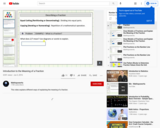
This video explains different ways of explaining the meaning of a fraction.
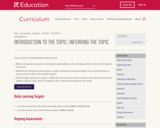
In this lesson, students participate in the Infer the Topic protocol to familiarize themselves with the module topic, using resources from the texts they will be reading throughout the module (RI.3.1, W.3.8, SL.3.1).
Throughout this module, students will revisit the module guiding questions introduced in this lesson. It is important to be sensitive to students' and families' feelings and experiences with regard to education, books, and reading and to acknowledge that these feelings and experiences may differ greatly, from very positive to somewhat neutral to very negative. This issue is discussed more in the next lesson, but it is important to be prepared to handle it sensitively should it arise. The main point students should understand by the end of this module is that education, books, and reading are important for college and career readiness, and that is the reason for the emphasis on education, books, and reading in this module. Students reflect on the module guiding questions at home with their families.
This lesson is the first of two that include built-out instruction for strategic use of the Think-Pair-Share protocol to promote productive and equitable conversation.
During all interaction, be aware that partnering with, looking at, talking with, or touching the opposite gender may be uncomfortable and inappropriate for students from other cultures. In addition, some students may believe it is inappropriate to speak with other students at all during class. Let them know that in the United States, speaking with a peer of either gender when the teacher gives the signal is appropriate, and it is one way that students can become independent learners and develop their content knowledge and language ability. At the same time, tell them you respect their needs, and if necessary, seek alternative arrangements for students according to their cultural traditions.
This lesson uses cold calling, or calling on students without them volunteering, as a total participation technique. Be aware that cold calling may be unfamiliar or embarrassing to some students. Prepare students and their families by telling them that cold calling in the United States is common and is a protocol that helps to ensure that all student voices are heard and respected. The protocol also provides the teacher with one way to assess what students know.
This lesson uses total participation techniques for quick response questions. Some common total participation techniques include cold calling, selecting volunteers, and using equity sticks (a stick or card for each student in the class).

Introduction to place value

This activity examines species richness to gain insight to evolutionary selection factors that encourage greater diversity.
GeoInquiries are designed to be fast and easy-to-use instructional resources that incorporate advanced web mapping technology. Each 15-minute activity in a collection is intended to be presented by the instructor from a single computer/projector classroom arrangement. No installation, fees, or logins are necessary to use these materials and software.

This video is part of the Learn and Grow with WHRO TV series. Watch Patty Larson teach about identifying and producing words that rhyme and the letters Ii, Nn, and Uu.
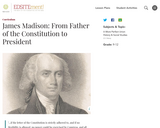
Even in its first 30 years of existence, the U.S. Constitution had to prove its durability and flexibility in a variety of disputes. More often than not, James Madison, the "Father of the Constitution," took part in the discussion.
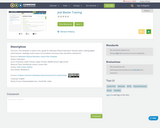
This template is meant to be a guide for Nebraska Physical Education Teachers when creating digital online lessons. Headings and/or topics not included in the lesson plan should be marked N/A.
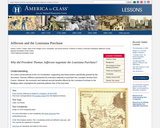
In this lesson students will analyze a private letter that President Thomas Jefferson (1743–1826) sent to Robert Livingston (1746–1813), his minister plenipotentiary (ambassador) to France, regarding the negotiations for what would become the Louisiana Purchase. Livingston and James Monroe (1758–1831, 6th president of the US) negotiated the Louisiana Purchase Treaty. It is important to note that at the time this letter was written — April 18, 1802 — the area had not yet been offered for sale.
In this letter Jefferson, unaware of the possibility of outright purchase, focuses upon retaining commercial access to the Mississippi River and rights of deposit (economic access) in New Orleans. He also comments upon the danger of an aggressive France locating outposts just across the Mississippi River from the United States. While some historians characterize Jefferson as a Francophile, in this letter Jefferson sees France as a potential enemy to the United States.
This lesson allows students to contextualize what will become the Louisiana Purchase prior to its acquisition by viewing the Purchase through a lens of national economic and military defense rather than an act of territorial expansion. As Jefferson considers the possibility of an aggressive France led by Napoleon Bonaparte on America’s doorstep, he states, “…perhaps nothing since the revolutionary war has produced more uneasy sensations through the body of the nation.” Original spellings and punctuation are retained.
This lesson is divided into two parts, both accessible below. The text is accompanied by close reading questions, student interactives, and an optional follow-up assignment. The teacher’s guide includes a background note, the text analysis with responses to the close reading questions, access to the interactive exercises, and the follow-up assignment. The student’s version, an interactive PDF, contains all of the above except the responses to the close reading questions and the follow-up assignment.

Educators can use the toolkit as a whole or borrow pieces to meet their unique learning objectives and circumstances. You may watch the film in the classroom or assign it to your students to watch on their own time. Many of these activities can be assigned virtually, as many schools will not resume in-person classrooms during 2020. The film can also be useful for student groups and associations.
The film has been divided up into 3 sections to accommodate for classroom viewing. Each section includes discussion questions, a lesson plan, and a lab. All of the student-facing materials are available on the website while the lesson plans and video links are accessible by signing up for a free screening license. All activities have NGSS and/or AP Bio standards alignment.
We also have 2 activities geared toward career exploration. We need young people to enter the fields of science now more than ever! Finally, we have some bonus materials that include materials created by other educators that can be useful as well. If you would like to submit an activity for us to include and share with other educators, please email breakthrough@uncommonproductions.com.
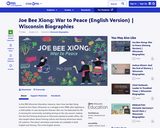
A video with downloadable leveled books and activity guide
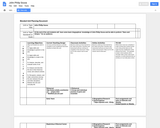
This unit will introduce students to the great American composer John Philip Sousa. They will be learning about his life and accomplishments along with learning and performing a portion of Stars and Stripes which has been simplified for their skill level. When complete the students will have a greater understanding and appreciation of this great march and the March King.
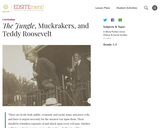
Curriculum unit on the historical context of Upton Sinclair's novel The Jungle and how the book helped reform efforts in Congress to pass the Meat Inspection Act and the Pure Food and Drug Act in 1906.

Overview: Learning Letters is a collection of all of the K-2 Reading Foundations Skills Block curricular materials related to learning about letter names, sounds, and formation. The contents include the research behind EL Education's approach to teaching letters, Letter Stories (engaging read-alouds, one for each letter of the alphabet and consonant digraph ("ch", "sh", and"th"), upper- and lowercase Keyword Cards (a colorful picture of the animal or object associated with each letter, and Handwriting Sheets (letter formation and handwriting practice sheets).
To access this resource, you will need to create a free account for the system on which it resides. This partner uses such data for funding requests to keep their resource growing and up-to-date. Also, these resources are openly-licensed for editing and re-sharing, EXCEPT for certain copyright-protected content (authentic texts, photographs, etc.) within the materials that are from outside sources. This outside content may not be reproduced or distributed (outside the scope of fair use or the EL Education Curriculum Terms of Use) without additional permissions from the content owner.
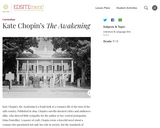
In this curriculum unit, students will explore how Chopin stages the possible roles for women in Edna's time and culture through the examples of other characters in the novella.
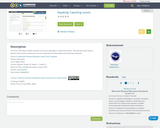
This lesson allows students to practice capsizing in a safe environment. They will also learn how to perform self rescues and partner rescues to get back into their kayak once they have capsized.
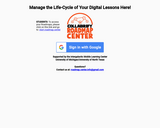
The first lesson in a series of lessons in Roadmaps that go with the Michigan Open Book and MC3 resources. This lesson talks about why there are rules at home and at school. The lesson contains some fun videos, text with pictures and song in the learning.
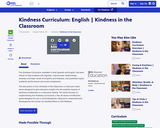
The Kindness Curriculum, available in both Spanish and English, has been shown to help students self-regulate, improve peer relationships, develop a stronger sense of empathy and kindness, and positively impact academic performance and social competence.

The Literacy Design Collaborative (LDC) provides a curriculum alignment system that helps teachers deliver standards-driven assignments in which students write in response to reading in discipline-specific ways supported by backwards-designed instruction.
LDC tools and learning experiences help teachers and schools meet the challenges of: (1) increasing the rigor of assignments, lessons, and units by becoming truly standards-driven, (2) increasing teachers' knowledge and expertise around instructional planning, and (3) radically changing the expectations schools and teachers have for their students' ability to read and write with depth and breadth—in other words, to be truly college and career ready.
The LDC CoreTools platform includes: (1) a free Curriculum Library that includes nationally-validated tasks and instructional plans that can be modified to meet any teacher's needs; (2) template-driven task and instructional plan editing tools that can be used collaboratively; (3) student-work rubrics and a curriculum-alignment rubric; (4) free professional learning experiences; (5) premium professional learning experiences, resources, and analytics.
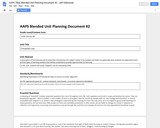
This is a lesson on L'Hospital's rule which is an AP Calculus AB/BC topic. Students will learn about indeterminate forms and how to use a derivative to determine the limit.